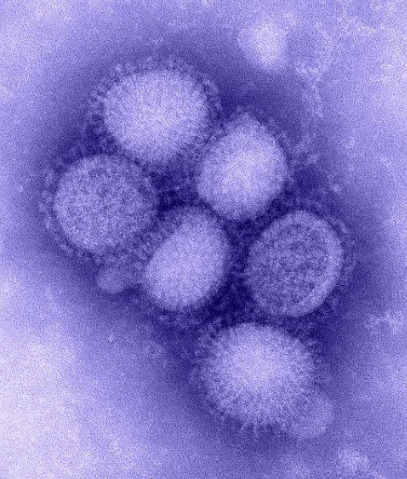Viruses, Part I: Origins
The Basis of Life As We Know It?

Although viruses can be found in every living organism today, their evolutionary origins, and their relationship to our own evolution, have been long debated.
What It Means to Be “Alive”: One of the longest-standing debates regarding viruses is whether they are “alive” or not. To many, viruses are considered not alive primarily because they require assistance to replicate themselves. True, viruses have genetic material (DNA or RNA) and a protective shell made of protein that surrounds their tiny genome, but that’s about it. They don’t have the proteins needed to copy their genome or to make more proteins, both necessary for reproduction. But “living” organisms on Earth do have these abilities. Consequently, viruses must find a host and “borrow” its cellular machinery in order to reproduce.
Once a virus has found a host cell, it can fool the cell into granting it access. (The virus usually does this by binding a specific receptor on the outside of the cell.) The virus’s DNA or RNA enters the cell, which starts making viral proteins and more viral genetic material.
Because the virus essentially gets a “free ride,” it can easily out-compete the cell, which now, in essence, has two mouths to feed. The cell creates more viruses until they mature and are released from the cell to find new host cells. While there are many variations, today we are quite familiar with the virus’s general plan of attack.

However, it was only over the last century that we learned anything about viruses on this molecular level. Because viruses are much smaller than even a bacteria cell, their discovery and characterization awaited the development of advanced techniques. In the late 1800s, the tobacco mosaic virus (then known as the tobacco mosaic disease) was devastating tobacco crops in Russia and Europe. The Russian botanist Dmitry Ivanovsky filtered the sap from these infected plants with a Pasteur-Chamberlain filter (invented by Louis Pasteur and Charles Chamberlain), which traps bacteria, the smallest known pathogen. However, the filtered sap could still infect other plants, indicating that it was something smaller than bacteria at work.
Scientists long suspected that a toxin in the sap, produced by bacteria, was causing the infections. This hypothetical toxin was called a “virus,” Latin for “poison” or “poisonous slime.” It wasn’t until the 1930s that advanced techniques allowed researchers to see a virus’s chemical structure, and only in the 1950s did it become apparent that viruses are truly a molecular genetic parasite. While we have come a long way, there is still a great deal we do not understand about viruses.
The Power of Diversity: Variety is one of viruses’ most astonishing, and least characterized, features. No organism is safe; viruses today infect every organism on earth, and sometimes even other viruses. While the virus database as of 2005 contained about 3,600 viruses, plus around 30,000 virus strains (different variant of the same virus), this barely touches the tip of the iceberg. There are probably fewer than 1,000 human-specific viruses, but it’s thought that thousands more are contained within our very genomes, although luckily they are mostly inactive. (More on that in next week’s article.)
To get a glimpse of just how very little we know about virus diversity, one only needs to look at the oceans, where an estimated ten to the power of 31 (that’s about as many as all the stars in the universe times one billion) mostly unclassified virus particles reside.
So how do viruses achieve such remarkable diversity? In short, by mutating and reproducing very quickly. Studies have shown that just one T cell (a type of white blood cell) infected with HIV (of the same, identical strain) can cause 10,000 variants of the virus. This is from a single infection; it’s practically impossible to comprehend the number of variants created from a viral epidemic. Viruses evolve so much faster than their hosts that it is difficult for the host to evolve a defense against the virus; HIV itself evolves about one million times faster than humans do.
But even viruses have their limits. If the virus makes too many mistakes, or mutations, it can no longer function. Additionally, often a given virus (and its variants) targets a single protein to gain entry into the host cell; if the host has a mutation in that one protein, the virus may not get in.
This has been seen with HIV. About 5 to 14 percent of Europeans have a mutated version of a protein called CCR5, which HIV interacts with to enter T cells. Consequently, people with this mutated version of CCR5 cannot easily be infected with HIV.
Where Did Viruses Come From? So where did these remarkable parasites come from? Because viruses do not leave fossils, it has been hard for researchers to track down their evolutionary history. Consequently, much of our understanding of the history of viruses is based on their genetics. Because they change so quickly, some researchers think that the viruses we are familiar with today evolved relatively recently, maybe within only the last 10,000 years. They may not have even known to the Neanderthals, who went extinct about 30,000 years ago.
But one must look much further back to see the possible origins of viruses. According to fossils, around 3.8 billion years ago Earth became populated with its first cellular life forms, bacteria and archaea. But it’s unclear what immediately preceded them; how did these organisms come to be? Once again, researchers have turned to genetics to try and answer this question. It’s been found that all organisms on Earth have about 350 genes in common (the human genome has about 20,000 to 25,000 genes total). These few hundred genes are thought to have all belonged to the oldest life form which everything today is descended from, or what is called the “last universal common ancestor” (LUCA).
There has been much speculation as to what the LUCA was exactly, and much of it probably comes down to RNA. Why RNA? Traditionally, cells turn their genomes, which are made up of DNA, into RNA. The RNA is then translated into amino acids to create the proteins the cells need.
However, there’s much evidence to support the idea that originally genetic material was stored as RNA, that RNA was not simply the middleman between DNA and proteins. One such clue is that RNA can perform functions DNA cannot. For example, RNA can catalyze chemical reactions and replicate itself, making more RNA, whereas DNA needs other proteins to make more DNA.
So, RNA probably got along fine all by itself for a while. Over an unimaginably long amount of time, pools of sequences of catalytic RNA (called “ribozymes” today), exchanging and replicating different genetic elements, may have created proteins that allowed for genetic information to be stored as DNA. And once DNA was up and running, it looks like it was downhill for RNA, because while RNA can replicate itself, it’s not nearly as efficient a replicator as DNA (when DNA has the help of some necessary proteins). RNA consequently became relegated to being a DNA-protein middleman. Genetic studies on the LUCA support this “RNA World Hypothesis;” of the 350-or-so genes everything shares, there are no genes for replicating a DNA genome.
And what, you might ask, does this have to do with viruses? Today, only RNA viruses have an RNA-based genome. No other organisms know how to replicate RNA, only how to turn it into protein. Consequently, such RNA viruses are possibly the only descendants of the pre-biotic “RNA World.”
This, and other supporting evidence, such as the fact that many viruses today can easily hold 350 genes in their genomes, has led some researchers to propose that the LUCA was actually a kind of virus itself, though the idea is very hotly debated. If they were not the LUCA itself, viruses may have easily been one of the first on the scene. Some theorize that viruses were created from genetic material that “escaped” from other organisms over time.
Next Time: No matter what their exact ancient origins, after billions of years of evolution viruses today are an integral part of life. Indeed, they constantly work to sneak back into our cells and genomes. Next week in “Biology Bytes” we’ll explore how this has led to a variety of human diseases and cancers, as well as several useful, medically-relevant applications—and what it means that eight percent of our genomes are from viruses.
For more on viruses and their origins, see Luis P. Villarreal’s book Viruses and the Evolution of Life; the book The Biology of Viruses by Bruce A. Voyles; Barry E. Zimmerman and David J. Zimmerman’s book Microbes and Diseases That Threaten Humanity and Wikipedia’s article “Virus.”
Biology Bytes author Teisha Rowland is a science writer, blogger at All Things Stem Cell, and graduate student in molecular, cellular, and developmental biology at UCSB, where she studies stem cells. Send any ideas for future columns to her at science@independent.com.



